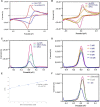Tuberculosis detection from raw sputum samples using Au-electroplated screen-printed electrodes as E-DNA sensor
- PMID: 36479437
- PMCID: PMC9720118
- DOI: 10.3389/fchem.2022.1046930
Tuberculosis detection from raw sputum samples using Au-electroplated screen-printed electrodes as E-DNA sensor
Abstract
Tuberculosis (TB) remains a leading cause of death globally, especially in underdeveloped nations. The main impediment to TB eradication is a lack of efficient diagnostic tools for disease diagnosis. In this work, label free and ultrasensitive electrochemical DNA biosensor for detecting Mycobacterium tuberculosis has been developed based on the electrodeposition of gold nanoparticles on the surface of carbon screen-printed carbon electrode (Zensors) for signal amplification. Particularly, screen-printed electrodes were modified by electrochemical deposition of Au to enhance the conductivity and facilitate the immobilization of ssDNA probes via Au-S bonds. The electrochemically modified SPEs were characterized using Scanning electron microscopy/Energy Dispersive X-Ray Analysis (SEM/EDX) and X-Ray Diffraction (XRD). Cyclic voltammetry (CV) and differential pulse voltammetry (DPV) techniques were used to investigate the DNA hybridization between single-stranded (ssDNA) probe and target DNA (tDNA). Under the ideal conditions, DPV exhibited a correlation coefficient R2 = 0.97, when analyzed with different tDNA concentrations. The proposed DNA biosensor exhibits a good detection range from 2 to 10 nm with a low detection limit of 1.91 nm, as well as high selectivity that, under ideal conditions, distinguishes non-complementary DNA from perfectly matched tDNA. By eliminating the need for DNA purification, this work paves the path for creating disposable biosensors capable of detecting DNA from raw sputum samples.
Keywords: IS-6110; electrochemical biosensing; mtb detection; screen printed electrode (SPE); tuberculosis.
Copyright © 2022 Sharif, Taufiq, Sohail and Abbas.
Conflict of interest statement
The authors declare that the research was conducted in the absence of any commercial or financial relationships that could be construed as a potential conflict of interest.
Figures





Similar articles
-
Towards portable rapid TB biosensor: Detecting Mycobacterium tuberculosis in raw sputum samples using functionalized screen printed electrodes.Bioelectrochemistry. 2023 Apr;150:108353. doi: 10.1016/j.bioelechem.2022.108353. Epub 2022 Dec 17. Bioelectrochemistry. 2023. PMID: 36603412
-
A new strategy to design label-free electrochemical biosensor for ultrasensitive diagnosis of CYFRA 21-1 as a biomarker for detection of non-small cell lung cancer.Chemosphere. 2022 Aug;301:134636. doi: 10.1016/j.chemosphere.2022.134636. Epub 2022 Apr 18. Chemosphere. 2022. PMID: 35447211
-
Electrochemical DNA Biosensor Based on Mercaptopropionic Acid-Capped ZnS Quantum Dots for Determination of the Gender of Arowana Fish.Biosensors (Basel). 2022 Aug 17;12(8):650. doi: 10.3390/bios12080650. Biosensors (Basel). 2022. PMID: 36005045 Free PMC article.
-
Printable Electrochemical Biosensors: A Focus on Screen-Printed Electrodes and Their Application.Sensors (Basel). 2016 Oct 21;16(10):1761. doi: 10.3390/s16101761. Sensors (Basel). 2016. PMID: 27775661 Free PMC article. Review.
-
Magnetic Particles Coupled to Disposable Screen Printed Transducers for Electrochemical Biosensing.Sensors (Basel). 2016 Sep 25;16(10):1585. doi: 10.3390/s16101585. Sensors (Basel). 2016. PMID: 27681733 Free PMC article. Review.
References
-
- Carbone M., Nestico A., Bellucci N., Micheli L., Palleschi G. (2017). Enhanced performances of sensors based on screen printed electrodes modified with nanosized NiO particles. Electrochimica Acta 246, 580–587. 10.1016/J.ELECTACTA.2017.06.074 - DOI
-
- Chen Y., Guo S., Zhao M., Zhang P., Xin Z., Tao J., et al. (2018). Amperometric DNA biosensor for Mycobacterium tuberculosis detection using flower-like carbon nanotubes-polyaniline nanohybrid and enzyme-assisted signal amplification strategy. Biosens. Bioelectron. 119, 215–220. 10.1016/J.BIOS.2018.08.023 - DOI - PubMed
-
- Chu Z. J., Xiao S. J., Liu Y. H., Xiong G. L., Huang D. J., Wang S. p., et al. (2019). Rapid and sensitive detection of the IS6110 gene sequences of Mycobacterium tuberculosis based on hybridization chain reaction and reusable magnetic particles. Sensors Actuators B Chem. 282, 904–909. 10.1016/J.SNB.2018.11.146 - DOI
LinkOut - more resources
Full Text Sources

